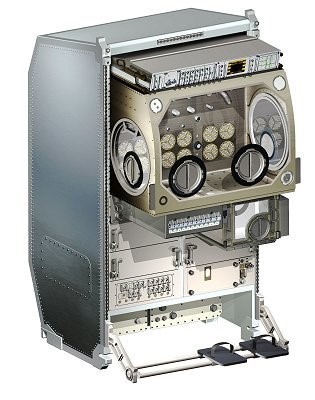Microgravity Science Glovebox
The Microgravity Science Glovebox (MSG) is a facility designed and developed by the European Space Agency (ESA) and managed by National Aeronautics and Space Administration (NASA)’s Marshall Space Flight Center (MSFC), currently located at the U.S.Laboratory called Destiny.
The Microgravity Science Glovebox fully occupies an International Standard Payload Rack.
From its launch in June 2002, MSG is one of the most profitable and versatile facility from the International Space Station (ISS)
as it is able to shelter experiments from different branch of knowledge: fluid dynamics, combustion, biologicals among others disciplines.
This facility offers an enclosed 255-liter work area accessible through the ports which allow crew to manipulate and install relatively large experiments on it workbench. Once the payload is install on the baseplate, it can be manipulated by crew through sealed gloves ports or remotely by ground operators through data links. Crew operations are safe as the work-volume is complete seal when closed and prevent hazardous material to escape from it.
This work volume provides to investigators a clean work environment – equivalent to a clean room environment – for conducting science experiment which could be hazardous or messy if materials were allowed to float freely in the module, that require human manipulation. By means of a negative pressure, sealed ports and an airlock for transferring objects two level of containment are secured.
MSG not only provide this unique work environment but also include:
- Core Facility with the extendable and retractable work volume area provide a cold plate to evacuate heat and power from the payload and data and power interfaces.
- By means of Space Acceleration Measurements System, could measure vibration and acceleration disturbances.
- Powered video drawer and cameras to monitor science investigations.
- MSG Laptop (MLC) which interface to payload.
E-USOC is the Facility Support Centre (FSC) for payload developed by the ESA, and its main task is to remotely operate the several Payloads installed in the work volume (e.g. SODI missions). The individual science team members may monitor the processing of their experiments from their User Home Bases.

Source: ESA